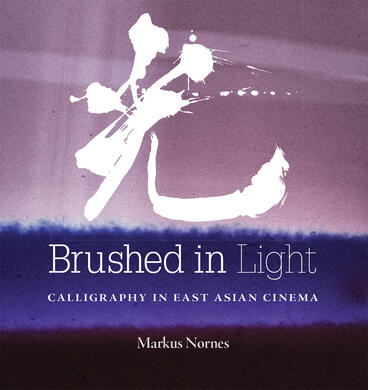Brushed in Light
Calligraphy in East Asian Cinema
The brushed word in films and film cultures of Korea, Japan, Taiwan, Hong Kong, and PRC
Description
Drawing on a millennia of calligraphy theory and history, Brushed in Light examines how the brushed word appears in films and in film cultures of Korea, Japan, Taiwan, Hong Kong, and PRC cinemas. This includes silent era intertitles, subtitles, title frames, letters, graffiti, end titles, and props. Markus Nornes also looks at the role of calligraphy in film culture at large, from gifts to correspondence to advertising. The book begins with a historical dimension, tracking how calligraphy is initially used in early cinema and how it is continually rearticulated by transforming conventions and the integration of new technologies. These chapters ask how calligraphy creates new meaning in cinema and demonstrate how calligraphy, cinematography, and acting work together in a single film. The last part of the book moves to other regions of theory. Nornes explores the cinematization of the handwritten word and explores how calligraphers understand their own work.
Markus Nornes is Professor of Asian Cinema at the University of Michigan.
Reviews
“In a study both erudite and contemplative, Nornes tracks the journey of the calligraphic arts across histories and regions into the world of cinema, where he uses them dexterously to disaggregate the monolithic object of film studies, finding other forms of screen life, other modes of cinematic existence, arising where cinematography encounters the figural force of calligraphy in an intermedial tremor of energy, and compels it to ask, ‘Who is the third who walks always beside you?’ It is a gesture well worth at least a thousand words.”
- Thomas Lamarre, University of Chicago
—Thomas Lamarre, University of Chicago
“Markus Nornes is a passionate pathfinder into the forest of affinities between cinema and calligraphy. He takes us deeper and deeper into that forest, analyzing beautiful brushed writing from Chinese, Japanese, and Korean cinema. The result is a revealing tour of the meaning—but also the physicality, almost the sensuality—of calligraphy. He quotes brilliantly from other scholars, and connects us back to the Western idea of the caméra-stylo, but mostly he is on exciting new ground. Myriad frame grabs enrich his tour, and—in sentences like ‘calligraphy sits in a place as undecidable as cinema’—we are close to poetry. A visual and intellectual delight.”
- Mark Cousins, filmmaker and critic
—Mark Cousins, filmmaker and critic
“When you see East Asian calligraphy in a film, you probably just want to know what it means. Brushed in Light asks us to look again. Calligraphy in Chinese, Japanese, and Korean cinema generates emotions and energies before you even know what it means. After you read this luxuriously illustrated revelation of a book, you will become conscious of calligraphy’s integral role in the design and storytelling of every East Asian film you watch. You will never let it slip by unnoticed again.”
- Chris Berry, King’s College London
—Chris Berry, King’s College London
"Markus Nornes’ Brushed in Light is a fantastic investigation of the history and importance of calligraphy in East Asian cinema...The text is not only original in its fundamental topic, but fascinating in its depth of detail and generally superb in its execution. Nornes deftly combines discussions of calligraphy’s history and conservative protection under formal schools with the novel, playful, and exceptional use in cinema in a way that is engaging even to those without a background in the various fields his book straddles." - International Journal of Asian Studies
- International Journal of Asian Studies
Supplemental Materials
Please see our Fulcrum platform for additional resources related to this title.

